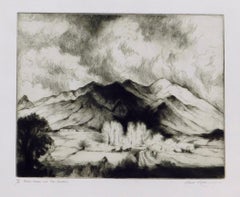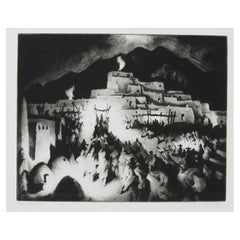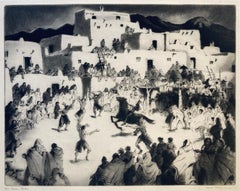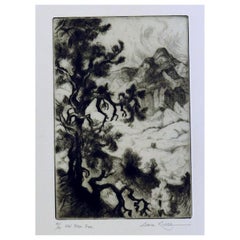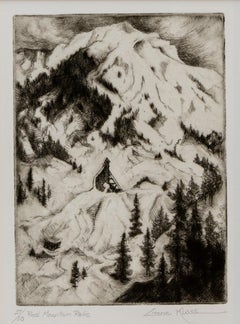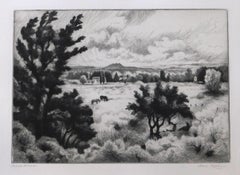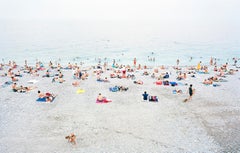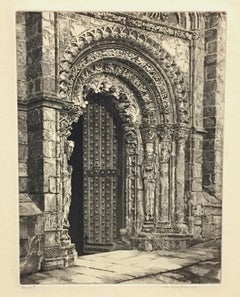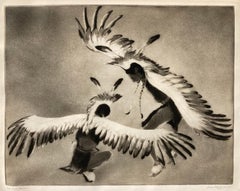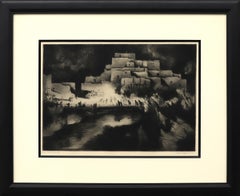Gene Kloss Art
American, 1903-1996
Gene (Alice Geneva) Kloss is considered one of America’s master printmakers. She was born in Oakland, California and established herself as an artist on the West coast.
Kloss was introduced to etching by Perham Nahl while at UC Berkley. She graduated in 1924, and in 1925 married poet Phillips Kloss. In her late twenties, Kloss moved to Taos, New Mexico and began her life’s work of the New Mexican landscape and peoples. It was at this time that she received national acclaim.
Her artwork exudes an unmistakable content and style. Enchanted by the architecture, mountainous landscapes and rituals of the inhabitants, Kloss captured the beauty of the Southwest and surrounding areas. Her style was bold yet deftly simple, masterfully expressing the elusive Southwestern light.
In 1938, she exhibited in Paris with Ernest Blumenschein, Georgia O’Keeffe, and John Sloan. She was also a member of the National Academy of Design, New York.to
5
6
1
Overall Width
to
Overall Height
to
12
1
2
1
1
2
3
8
4
6
5
4
3
2
2
2
1
1
1
1
1
1
1
5
4
4
4
2
12
7,736
4,946
2,504
1,373
2
2
12
Artist: Gene Kloss
Gene Kloss Original Pencil Signed Etching. Adobe House and Taos Mountain
By Gene Kloss
Located in Phoenix, AZ
Etching and drypoint on paper by famous Taos Artist Gene Kloss (1903-1996).
Title: Adobe Houses and Taos Mountain. Unframed and un-matted. Kloss #483
Pencil titled lower left. Pencil...
Category
Mid-20th Century Gene Kloss Art
Materials
Aquatint
Taos Artist Gene Kloss Original Drypoint, Christmas Eve, Taos Pueblo
By Gene Kloss
Located in Phoenix, AZ
Drypoint etching by famous Taos Artist Gene Kloss (1903-1996).
Edition of 75. Titled: Christmas Eve - Taos Pueblo.
Image measures: 12" H x 15" W.
Unframed. Archivally matted.
Created...
Category
Mid-20th Century Gene Kloss Art
Materials
Paper
TAOS INDIAN JESTERS
By Gene Kloss
Located in Santa Monica, CA
GENE KLOSS (1903 – 1996)
TAOS INDIAN JESTERS, 1944
Etching and aquatint, Signed and titled in pencil. Edition 30. Image 11” x 13 7/8”, sheet 13 ¼ x 16 ½”. In very good condition sa...
Category
1940s American Realist Gene Kloss Art
Materials
Etching, Aquatint
Gene Kloss Original Etching, 1981 - "Old Pinon Tree"
By Gene Kloss
Located in Phoenix, AZ
Etching & Drypoint on paper by famous Taos Artist Gene Kloss (1903-1996).
Titled: “Old Pinon Tree.” Pencil signed lower right and in excellent condition.
Image measures: 8" H x 6" W....
Category
1980s Gene Kloss Art
Materials
Paper
Red Mountain Relic (View of Red Mountain, Colorado), Signed Black & White Print
By Gene Kloss
Located in Denver, CO
A stunning example of American printmaking, “Red Mountain Relic” is an original etching with drypoint by acclaimed artist Gene Kloss (1903–1996). This atmospheric composition capture...
Category
Mid-20th Century American Modern Gene Kloss Art
Materials
Etching
Taos Artist Gene Kloss Original Etching. Indian Summer
By Gene Kloss
Located in Phoenix, AZ
Original Etching by famous Taos Artist Gene Kloss (1903-1996). Full Margins.
Edition of 75. Titled: Indian Summer. Image measures: 7 3/4" H x 11 1/8" W.
Unframed. Archivally matted. ...
Category
Mid-20th Century Gene Kloss Art
Materials
Paper, Etching
Indian Friendship Dance
By Gene Kloss
Located in Fairlawn, OH
Indian Friendship Dance
Drypoint, 1953
Signed in pencil lower right, (see photo)
Edition 200
Published by The Society of American Graphic Artists, New York
An impression is in the collection of SAAM, Washington and RISD Museum,
Condition: Excellent
Very rich impression with burr and selective whiping of the ink for atmospheric nocturnal effect.
Image/Plate size: 8 3/16 x 11 15/16 inches
Sheet size: 11 1/8 x 17 inches
Reference: Kloss 450
"'Indian Friendship Dance' is an eloquent statement of something which Gene Kloss has both observed and participated in. It is an Indian dance that is thought of as entertainment, rather than ceremony, but it is essentially an idea expressed in action, and an idea that has universal meaning. The young men who dance wear costumes of exquisite workmanship, intricately wrought with beads and feathers and subtle combinations of colors. The dancers are trained from childhood but develop their own steps and exhibit distinctive strength and grace. Singers and a tom-tom accompany the dance and since it usually takes place at night, a campfire is the source of light. The conclusion occurs when all the onlookers, old and young and from many places, join hands with the dancers in a slow revolving movement, while those who can, sing the difficult but meaningful Indian song that flows with the rhythmical dance step and speaks of fellowship, brotherhood, friendship." - An excerpt from a descriptive statement, written by Lynd Ward, and distributed with the drypoint at the time of publication." Courtesy Old Print Shop
Born Alice Glasier in Oakland, CA, Kloss grew up amid the worldly bustle of the San Francisco Bay Area. She attended the University of California at Berkeley, graduating with honors in art in 1924. She discovered her talents in intaglio printmaking during a senior-year course in figurative drawing. The professor, Perham Nahl, held up a print from Kloss’ first plate, still damp from the printing process, and announced that she was destined to become a printmaker.
In 1925, Gene married Phillips Kloss, a poet and composer who became her creative partner for life. The match was uncanny, for in her own way Gene, too, was a poet and a composer. Like poetry, her artworks capture a moment in time; like music, her compositions sing with aesthetic harmony. Although she was largely self-taught, Kloss was a printmaking virtuoso.
On their honeymoon the Klosses traveled east from California, camping along the way. They spent two week is Taos Canyon – with a portable printing press cemented to a rock near their campsite – where Gene learned to appreciate the wealth of artistic subject matter in New Mexico. The landscape, the cultures, and the immense sky left an indelible impression on the couple, who returned every summer until they made Taos their permanent home 20 years later.
Throughout her life, Kloss etched more than 625 copper plates, producing editions ranging from five to 250 prints. She pulled every print in every edition herself, manually cranking the wheel of her geared Sturges press until she finally purchased a motorized one when she was in her 70s. Believing that subject matter dictated technique, she employed etching, drypoint, aquatint, mezzotint, roulette, softground, and a variety of experimental approaches, often combining several techniques on the same plate. She also produced both oil and watercolor paintings.
Kloss’ artworks are filled with drama. Her prints employ striking contrasts of darkness and light, and her subjects are often illuminated by mysterious light sources. Though she was a devout realist, there is also a devout abstraction on Kloss’ work that adds an almost mythical quality.
For six decades Kloss documented the cultures of the region-from images of daily life to those of rarely seen ceremonies. She and her husband shared a profound respect for the land and people, which made them welcome among the Native American and Hispanic communities. Kloss never owned a camera but relied instead on observation and recollection. Her works provide an inside look at the cultures she depicted yet at the same time communicate the awe and freshness of an outsider’s perspective.
Although Kloss is best known for her images of Native American and Penitente scenes, she found artistic inspiration wherever she was. During the early years of their marriage, when she and Phil returned to the Bay Area each winter to care for their aging families, she created images of the California coast. And when the Klosses moved to southwestern Colorado in 1965, she etched the mining towns and mountainous landscapes around her.
In 1970 the Klosses returned to Taos and built a house north of town. Though her artwork continued to grow in popularity, she remained faithful to Taos’ Gallery A, where she insisted that owner Mary Sanchez keep the prices of her work reasonable regardless of its market value. Kloss continued to etch until 1985, when declining health made printmaking too difficult.
From her first exhibition at San Francisco’s exclusive Gump’s in 1937 to her 1972 election to full membership in the National Academy of Design, Kloss experienced a selective fame. She received numerous awards, and though she is not as well known as members of the Taos Society of Artists...
Category
1950s American Realist Gene Kloss Art
Materials
Drypoint
1953 Signed Black & White Etching Print 'Ceremonial Day at Taos' New Mexico
By Gene Kloss
Located in Denver, CO
"Ceremonial Day at Taos" is a captivating vintage black and white etching by renowned American artist Gene Kloss. Created in 1953, this drypoint etching depicts the vibrant life of T...
Category
1950s American Modern Gene Kloss Art
Materials
Etching
Gene Kloss Original Pencil Signed Etching. Navajo Canyon Cliffs
By Gene Kloss
Located in Phoenix, AZ
Etching and drypoint on paper by famous Taos Artist Gene Kloss (1903-1996).
Title: Navajo Canyon Cliffs. Unframed and un-matted. Kloss #563
Pencil titled lower left. Pencil signed lo...
Category
Late 20th Century Gene Kloss Art
Materials
Drypoint
Keresan Dancers
By Gene Kloss
Located in Fairlawn, OH
Keresan Dancers
Etching & drypoint, 1962
Signed lower right (see photo)
Inscribed lower left: "Artist's Proof Keresan Dancers"
Depicts Keresan speaking peoples at Sam Felipe Pueblo
Contemporary Puebloans are customarily described as belonging to either the eastern or the western division. The eastern Pueblo villages are in New Mexico along the Rio Grande and comprise groups who speak Tanoan and Keresan languages. Tanoan languages such as Tewa are distantly related to Uto-Aztecan, but Keresan has no known affinities. The western Pueblo villages include the Hopi villages of northern Arizona and the Zuni, Acoma, and Laguna villages, all in western New Mexico.
Born Alice Glasier in Oakland, CA, Kloss grew up amid the worldly bustle of the San Francisco Bay Area. She attended the University of California at Berkeley, graduating with honors in art in 1924. She discovered her talents in intaglio printmaking during a senior-year course in figurative drawing. The professor, Perham Nahl, held up a print from Kloss’ first plate, still damp from the printing process, and announced that she was destined to become a printmaker.
In 1925, Gene married Phillips Kloss, a poet and composer who became her creative partner for life. The match was uncanny, for in her own way Gene, too, was a poet and a composer. Like poetry, her artworks capture a moment in time; like music, her compositions sing with aesthetic harmony. Although she was largely self-taught, Kloss was a printmaking virtuoso.
On their honeymoon the Klosses traveled east from California, camping along the way. They spent two week is Taos Canyon – with a portable printing press cemented to a rock near their campsite – where Gene learned to appreciate the wealth of artistic subject matter in New Mexico. The landscape, the cultures, and the immense sky left an indelible impression on the couple, who returned every summer until they made Taos their permanent home 20 years later.
Throughout her life, Kloss etched more than 625 copper plates, producing editions ranging from five to 250 prints. She pulled every print in every edition herself, manually cranking the wheel of her geared Sturges press until she finally purchased a motorized one when she was in her 70s. Believing that subject matter dictated technique, she employed etching, drypoint, aquatint, mezzotint, roulette, softground, and a variety of experimental approaches, often combining several techniques on the same plate. She also produced both oil and watercolor paintings.
Kloss’ artworks are filled with drama. Her prints employ striking contrasts of darkness and light, and her subjects are often illuminated by mysterious light sources. Though she was a devout realist, there is also a devout abstraction on Kloss’ work that adds an almost mythical quality.
For six decades Kloss documented the cultures of the region-from images of daily life to those of rarely seen ceremonies. She and her husband shared a profound respect for the land and people, which made them welcome among the Native American and Hispanic communities. Kloss never owned a camera but relied instead on observation and recollection. Her works provide an inside look at the cultures she depicted yet at the same time communicate the awe and freshness of an outsider’s perspective.
Although Kloss is best known for her images of Native American and Penitente scenes, she found artistic inspiration wherever she was. During the early years of their marriage, when she and Phil returned to the Bay Area each winter to care for their aging families, she created images of the California coast. And when the Klosses moved to southwestern Colorado in 1965, she etched the mining towns and mountainous landscapes around her.
In 1970 the Klosses returned to Taos and built a house north of town. Though her artwork continued to grow in popularity, she remained faithful to Taos’ Gallery A, where she insisted that owner Mary Sanchez keep the prices of her work reasonable regardless of its market value. Kloss continued to etch until 1985, when declining health made printmaking too difficult.
From her first exhibition at San Francisco’s exclusive Gump’s in 1937 to her 1972 election to full membership in the National Academy of Design, Kloss experienced a selective fame. She received numerous awards, and though she is not as well known as members of the Taos Society of Artists...
Category
1960s American Realist Gene Kloss Art
Materials
Drypoint
On Christmas Day
By Gene Kloss
Located in Fairlawn, OH
On Christmas Day
Drypoint and aquatint, 1979
Signed lower right: Gene Kloss (see photo)
Inscribed lower left:
"Artist's Proof", and titled "On Christmas Day"
An "artist's proof" impression, outside the edition of 25 examples signed and numbered
Reference: Sanchez 581
Condition: Excellent
Image/Plate size: 10 7/8 x 13 7/8 inches
Sheet size: 14 5/8 x 17 5/8 inches
Born Alice Glasier in Oakland, CA, Kloss grew up amid the worldly bustle of the San Francisco Bay Area. She attended the University of California at Berkeley, graduating with honors in art in 1924. She discovered her talents in intaglio printmaking during a senior-year course in figurative drawing. The professor, Perham Nahl, held up a print from Kloss’ first plate, still damp from the printing process, and announced that she was destined to become a printmaker.
In 1925, Gene married Phillips Kloss, a poet and composer who became her creative partner for life. The match was uncanny, for in her own way Gene, too, was a poet and a composer. Like poetry, her artworks capture a moment in time; like music, her compositions sing with aesthetic harmony. Although she was largely self-taught, Kloss was a printmaking virtuoso.
On their honeymoon the Klosses traveled east from California, camping along the way. They spent two week is Taos Canyon – with a portable printing press cemented to a rock near their campsite – where Gene learned to appreciate the wealth of artistic subject matter in New Mexico. The landscape, the cultures, and the immense sky left an indelible impression on the couple, who returned every summer until they made Taos their permanent home 20 years later.
Throughout her life, Kloss etched more than 625 copper plates, producing editions ranging from five to 250 prints. She pulled every print in every edition herself, manually cranking the wheel of her geared Sturges press until she finally purchased a motorized one when she was in her 70s. Believing that subject matter dictated technique, she employed etching, drypoint, aquatint, mezzotint, roulette, softground, and a variety of experimental approaches, often combining several techniques on the same plate. She also produced both oil and watercolor paintings.
Kloss’ artworks are filled with drama. Her prints employ striking contrasts of darkness and light, and her subjects are often illuminated by mysterious light sources. Though she was a devout realist, there is also a devout abstraction on Kloss’ work that adds an almost mythical quality.
For six decades Kloss documented the cultures of the region-from images of daily life to those of rarely seen ceremonies. She and her husband shared a profound respect for the land and people, which made them welcome among the Native American and Hispanic communities. Kloss never owned a camera but relied instead on observation and recollection. Her works provide an inside look at the cultures she depicted yet at the same time communicate the awe and freshness of an outsider’s perspective.
Although Kloss is best known for her images of Native American and Penitente scenes, she found artistic inspiration wherever she was. During the early years of their marriage, when she and Phil returned to the Bay Area each winter to care for their aging families, she created images of the California coast. And when the Klosses moved to southwestern Colorado in 1965, she etched the mining towns and mountainous landscapes around her.
In 1970 the Klosses returned to Taos and built a house north of town. Though her artwork continued to grow in popularity, she remained faithful to Taos’ Gallery A, where she insisted that owner Mary Sanchez keep the prices of her work reasonable regardless of its market value. Kloss continued to etch until 1985, when declining health made printmaking too difficult.
From her first exhibition at San Francisco’s exclusive Gump’s in 1937 to her 1972 election to full membership in the National Academy of Design, Kloss experienced a selective fame. She received numerous awards, and though she is not as well known as members of the Taos Society of Artists...
Category
1970s American Modern Gene Kloss Art
Materials
Drypoint
Gene Kloss Etching, 1982 - "Pueblo Dancer"
By Gene Kloss
Located in Phoenix, AZ
Drypoint on paper by famous Taos Artist Gene Kloss (1903-1996).
Titled: “Pueblo Dancer.” Pencil signed lower right and in excellent condition.
Image measures: 8" H x 6" W. Sheet size...
Category
1980s Gene Kloss Art
Materials
Paper
Related Items
Nizza - large format photograph of summer beach observation in South of France
By Frank Schott
Located in San Francisco, CA
Large scale highly detailed photograph of European summer beach scene captured in coastal Nice, France, along the Mediterranean Côte d’Azur.
Nizza (2006) by Frank Schott
44 x 69 in...
Category
21st Century and Contemporary Contemporary Gene Kloss Art
Materials
Archival Paper, Photographic Paper, Archival Pigment, Giclée, Archival Ink
H 44 in W 69 in D 0.03 in
John Taylor Arms, Study in Stone, Cathedral of Ourense
By John Taylor Arms
Located in New York, NY
John Taylor Arms was known for making such finely drawn etchings that commercial tools were not good enough: He regularly used sewing needles with corks ...
Category
Mid-20th Century American Realist Gene Kloss Art
Materials
Etching
Old Brownstones -- New York
By Lawrence Wilbur
Located in Storrs, CT
Old Brownstones-- New York. c. 1985. Etching and drypoint. 8 7/ 8 x 12 1/3 (sheet 16 5/8 x 16 1/4). Fourth state. Printed on cream wove paper, on the full sheet with deckle edges. A rich impression in pristine condition, housed in an archival folder. This etching has never been matted. Provenance: the artist's estate. Signed, titled, and annotated 'Fourth state -- wheel changed to left' and 'Steves' in pencil. A dramatic view of a Manhattan neighborhood.
Painter and printmaker Lawrence Nelson Wilbur...
Category
20th Century American Modern Gene Kloss Art
Materials
Drypoint, Etching
The Spire -- New York
By Lawrence Wilbur
Located in Storrs, CT
The Spire -- New York. 1985. Etching and drypoint. 14 1/2 x 11 (sheet 22 1/2 x 18). Trial proof of the second third, prior to the edition of 100. Printed on Rives cream wove paper, on the full sheet with deckle edges. A rich impression in pristine condition, housed in an archival sleeve. This etching has never been matted. Provenance: the artist's estate. Titled, annotated 'third state - trial proof' and signed in pencil. A dramatic view of the Chrysler Building.
Painter and printmaker Lawrence Nelson...
Category
20th Century American Modern Gene Kloss Art
Materials
Drypoint, Etching
Union Street, San Francisco
By Edith (Mark) Milsk
Located in San Francisco, CA
This artwork titled "Union Street, San Francisco" is an original etching on creme wove paper by American artist Edith (Mark) Milsk, 1899-1982. It is hand signed and titled in pencil by the artist. The plate mark (Image) size is 5.5 x 3.65 inches, framed size is 16.5 x 13.40 inches. Custom framed in a red Oak frame, with beige matting. It is in excellent condition.
About the artist:
Edith Milsk...
Category
Mid-20th Century American Realist Gene Kloss Art
Materials
Etching
Bending Pine, edition 1 of 5 (hand-printed cyanotype, 18 x 11 inches)
Located in Oakland, CA
The tree is a native Californian Monterey pine. They are found up and the down the coast of California from Carmel to San Francisco and all the way up north Mendocino. The moody scen...
Category
2010s Contemporary Gene Kloss Art
Materials
Paper, Archival Paper, Rag Paper, Photogram
Manhattan Mountains
By Lawrence Wilbur
Located in Storrs, CT
Manhattan Mountains. 1938. Etching and drypoint. 14 3/4 x 12 3/8 (sheet 17 1/4 x 14 3/4). Artist proof, previous to the edition of 40. An atmospheric impression printed on buff-colored laid paper. Signed and dated in the plate. Signed, titled, and annotated 'Final state' and 'Jones Proof'in pencil. Housed in an archival sleeve.
Painter and printmaker Lawrence Nelson...
Category
20th Century American Modern Gene Kloss Art
Materials
Drypoint, Etching
Nymphee, Surrealist Etching by Roberto Matta
By Roberto Matta
Located in Long Island City, NY
"Nymphee" is a colorful Roberto Matta etching from his Requiem pour la Fin des Temps suite. The print is signed and numbered (44/100) in pencil w...
Category
1970s Surrealist Gene Kloss Art
Materials
Etching, Aquatint
Charge into the Center of Consciousness, Takashi Murakami, Flowerballs print
By Takashi Murakami
Located in Bristol, GB
Offset print, cold stamp and high gloss varnishing
Edition of 300
Diameter: 71 cm (27.9 in)
Signed and numbered on front
Mint. Minor imperfections may appear due to the production pr...
Category
21st Century and Contemporary Contemporary Gene Kloss Art
Materials
Paper, Offset
Magnolia Night and Day Diptych (Two 8.5 x 11" hand-printed cyanotypes)
Located in Oakland, CA
These are two separate 11 x 8.5 inch (45 x 60 cm) hand-printed original cyanotype photographs sold sold together. They are the same image but one is printed from the negative and the...
Category
2010s Contemporary Gene Kloss Art
Materials
Paper, Archival Paper, Rag Paper, Photogram
Winter Tracery (Milford Connecticut)
Located in San Francisco, CA
This artwork titled 'Winter Tracery (Milford Connecticut)" is an original drypoint etching by noted American artist Philip Kappel, 1901-1981. It is hand signed and titled in pencil by the artist. The plate mark (Image) size is 9 x 12 inches, framed size is 17.25 x 21.25 inches. Custom framed in a wooden light grey frame, with light grey matting and black color fillet. It is in excellent condition.
About the artist:
Philip Kappel — painter, illustrator, printer, writer, and lecturer — was born on February 10, 1901 in Hartford, CT and died in 1981. Kappel is best remembered for his landscapes, portraits, figures, marine, lithography, and etching. He held a teaching position with H. B. Snell, Boothbay, ME Studios, 1923 and 1924. His addresses in 1929 were 500 Fifth Avenue in New York City and, for the summer, care of Philip Little, 10 Chestnut Street, Salem, MA; and in 1935, Sarasota, FL.
Kappel was a pupil of the Pratt Institute Art School in Brooklyn, NY and Philip Little (1857-1942) and held memberships with the North Shore Artists Association in Gloucester, MA; the Marblehead...
Category
Mid-20th Century American Realist Gene Kloss Art
Materials
Drypoint, Etching
Under the Bridge
By Lawrence Wilbur
Located in Storrs, CT
Under the Bridge. 1985. Etching and drypoint. 9 1/2 x 12 1/8 (sheet 20 1/16 x 22). Edition 27, #13. Printed on cream wove paper, on the full sheet with deckle edges. A rich impression in excellent condition, housed in an archival folder. The etching has never been matted. Titled and numbered in pencil. by the artist; signed and initialed in pencil by the artist's estate. Provenance: the artist's estate A dramatic view of the lower East Side in New York. Housed in an archival folder awaiting your choice of mat and frame.
Painter and printmaker Lawrence Nelson Wilbur...
Category
20th Century American Modern Gene Kloss Art
Materials
Etching, Drypoint
Previously Available Items
Taos Eagle Dance
By Gene Kloss
Located in Santa Monica, CA
GENE KLOSS (1903 – 1996)
TAOS EAGLE DANCE, 1955 (Sanchez 458)
Aquatint and drypoint, signed and titled in pencil. Plate 10 7/8 x 13 7/8”, sheet 13 ½ x 17”. Edition 35. Image in v...
Category
1950s American Modern Gene Kloss Art
Materials
Aquatint
Pueblo Firelight Dance, 1950s American Modernist Etching, New Mexico Village
By Gene Kloss
Located in Denver, CO
"Pueblo Firelight Dance (Edition 35)" is a black and white etching on paper by Kloss, Gene (Alice Geneva Glasier) (1903-1996) from 1952 of a Pueblo village in a nightscape with a fire and figures dancing around it. Presented in a frame, outer dimensions measure 21 ¼ x 26 x 1 inches. Image sight size 12 ½ x 17 inches.
Etching is clean and in good vintage condition - please contact us for a detailed condition report.
Provenance: Private collection, Denver, Colorado
Expedited and international shipping is available - please contact us for a quote.
About the Artist:
Gene Kloss is considered one of America’s master printmakers. Beginning her career in California, it was not until she moved to Taos, New Mexico, and began her life’s work of its landscape and peoples that she received national acclaim. Just as compelling as her subject matter was her creative, experimental approach to printing. Referring to her etching as "painting," she applied acid directly onto the plate with a fine Japanese brush or a pencil. Achieving a wide variety of tones and smooth color gradients, she developed a style characterized by deep, rich blacks and haloed white regions of light.
Born Alice Geneva Glasier, she got her Bachelors Degree of Arts from the University of California, Berkeley (1924) and studied at the California School of Fine Arts (1924-25). In a senior-year drawing class, the professor, Perham Nahl, held up a damp intaglio print from Kloss’ first plate presciently predicted she was destined to become a printmaker. So relying upon manuals, she set upon a course of self-education, which allowed her to be more daring in her explorations of process.
In 1925, she married Phillips Kloss, a poet and composer who was completely dedicated to her art — at times putting her creative needs before his own. On their honeymoon, the newlyweds traveled east, camping as they went along. Reaching New Mexico, they stayed for two week in Taos Canyon on the way up to the Sangre des Cristo Mountains, cementing a portable sixty-pound printing press to a rock near their campsite. With winters in Berkeley to care for their aging families, they returned for the better part of the year in Taos, until they became full-time residents in 1945. For a period the Klosses lived in southern Colorado, where she introduced its mountains and mining towns into her work.
Kloss began using the name Gene to avoid any bias against female artists. Whether Alice Kloss would have garnered fewer honors is a moot point, but Gene was well regarded by her peers, who elected her to Associate Membership in the prestigious National Academy of Design in 1950 and Full Membership in 1972—the first American woman printmaker ever to be so honored. In addition, she was considered one of the leading artists of New Mexico modernism, exhibiting alongside Ernest Blumenschein, Georgia O’Keefe, and John Sloan in Paris in 1938.
In the thirties, Kloss was employed by the WPA, making a series of prints of Mesa Verde that were distributed to schools. She became caught up with a fascination with the communal culture of Southwestern indigenous people: “The individual Indian is lost out of the tribe but meaningful in the group that integrates itself with nature that has evolved laws for society, divided labor for existence, developed the arts and crafts — all unified in a religion that is significantly expressed in the ceremonies.” Invited to Taos Pueblo, she wouldn’t take photographs or sketch in keeping with the strict regulations. Working from memory, she created scenes in which individual elements became part of dramatic composition, a sensibility seen throughout her work.
Adapting technique to subject matter, she employed etching, drypoint, aquatint, mezzotint, roulette, softground, and a variety of experimental approaches, often combining several techniques on the same plate. In total, Kloss etched more than 625 copper plates, comprising editions ranging from five to 250 prints. Pulling every print herself, she manually cranked the wheel of her geared Sturges press, until she purchased a motorized one in her 70s.
Education: University of California at Berkeley; California School of Fine Arts, San Francisco; California School of Arts and Crafts, Oakland.
Exhibited: Whitney Museum of American Art; Sweden; World’s Fair, New York; Golden Gate Exposition; United States Exhibition; Paris; Italy; Prairie Print...
Category
1950s American Modern Gene Kloss Art
Materials
Paper, Black and White, Etching
H 21.25 in W 26 in D 1 in
Adobes with Horses, Cattle, Summer Mountain Landscape, Framed Oil Painting
By Gene Kloss
Located in Denver, CO
Summertime Mountain Landscape Painting by Gene Kloss, Oil on board. Presented in a custom frame, outer dimensions measure 25 ¼ x 32 ¼ x 1 ½ inches. Image size is 20 ½ x 27 ½ inches.
Painting is clean and in very good vintage condition - please contact us for a detailed condition report.
Provenance: Private Collection, Colorado
Expedited and international shipping is available - please contact us for a quote.
About the Artist:
Gene (Alice Geneva) Kloss is considered one of America’s master printmakers. She was born in Oakland, California and established herself as an artist on the West coast.
Kloss was introduced to etching by Perham Nahl while at UC Berkley. She graduated in 1924, and in 1925 married poet Phillips Kloss. In her late twenties, Kloss moved to Taos, New Mexico and began her life’s work of the New Mexican landscape and peoples. It was at this time that she received national acclaim.
Her artwork exudes an unmistakable content and style. Enchanted by the architecture, mountainous landscapes and rituals of the inhabitants, Kloss captured the beauty of the Southwest and surrounding areas. Her style was bold yet deftly simple, masterfully expressing the elusive Southwestern light...
Category
20th Century American Impressionist Gene Kloss Art
Materials
Oil
H 25.25 in W 32.25 in D 1.5 in
Fog Over the Golden Gate (Scarce Large Kloss)
By Gene Kloss
Located in Santa Monica, CA
GENE KLOSS (1903 - 1996)
FOG OVER THE GOLDEN GATE, 1954 (Kloss 455)
Drypoint and aquatint signed and titled in pencil, annotated Artist Proof. Edition 35. Image, 10 ¾ x 13 ¾ inches....
Category
1950s Gene Kloss Art
Materials
Etching, Aquatint
Riders at Sundown
By Gene Kloss
Located in Myrtle Beach, SC
'Riders at Sundown', aquatint and drypoint, edition 75, Kloss 451, 1953. Signed and titled in pencil. A superb, richly-inked, atmospheric impression, in brown/black ink, on cream wov...
Category
1950s American Modern Gene Kloss Art
Materials
Drypoint, Aquatint
Processional - Taos
By Gene Kloss
Located in Myrtle Beach, SC
'Processional - Taos', aquatint and drypoint, edition 250, Kloss 431, 1948. Signed and titled in pencil. A superb, richly-inked impression, in warm black ink, with full margins (1 to...
Category
1940s American Modern Gene Kloss Art
Materials
Drypoint, Aquatint
Pilar
By Gene Kloss
Located in Myrtle Beach, SC
'Pilar', aquatint and drypoint, edition 75, Kloss 400, 1945. Signed and titled in pencil. A superb, atmospheric impression, in warm black ink, on cream, wove paper; full margins (3/4...
Category
1940s American Modern Gene Kloss Art
Materials
Drypoint, Aquatint
To a Wedding in North House
By Gene Kloss
Located in Missouri, MO
Gene Kloss (1903-1996)
"To a Wedding in North House" 1973
Drypoint and Etching
Sheet Size: approx 13 x 16
Signed Lower Right
Numbered Lower Left 10/50
Titled
Gene Kloss arrived in T...
Category
1970s American Modern Gene Kloss Art
Materials
Drypoint, Etching
Untitled (Snowy Mountain and Stream)
By Gene Kloss
Located in Denver, CO
A modernist painting of a hilly winter landscape with snow, trees and a stream (likely New Mexico) by Gene Kloss ( 1903-1996). Presented in a custom frame, outer dimensions measure ...
Category
20th Century American Modern Gene Kloss Art
Materials
Watercolor
RAIN OVER WIDE LANDS
By Gene Kloss
Located in Portland, ME
Kloss, Gene (American, 1903-1996).
RAIN OVER WIDE LANDS. Kloss 488.
Drypoint and aquatint, 1960.
Edition of 50, numbered 26/50, titled signed and inscribed "imp.," all in pencil. ...
Category
1960s Gene Kloss Art
Materials
Aquatint, Drypoint
CEREMONIAL BASKET
By Gene Kloss
Located in Santa Monica, CA
GENE KLOSS (1903 – 1996)
CEREMONIAL BASKET 1969 (K. 528)
Etching and aquatint, Edition 75, 10 3/8” X 8” $950
Indians, Southwest, S...
Category
1960s American Modern Gene Kloss Art
Materials
Etching
The Archer
By Gene Kloss
Located in Santa Monica, CA
GENE KLOSS (1903 – 1996)
THE ARCHER, 1964 (Kloss 500) Etching, edition 50, 15 x 12. Signed and
titled in pencil. ...
Category
1960s American Modern Gene Kloss Art
Materials
Etching
Gene Kloss art for sale on 1stDibs.
Find a wide variety of authentic Gene Kloss art available for sale on 1stDibs. You can also browse by medium to find art by Gene Kloss in etching, drypoint, engraving and more. Much of the original work by this artist or collective was created during the 20th century and is mostly associated with the modern style. Not every interior allows for large Gene Kloss art, so small editions measuring 11 inches across are available. Customers who are interested in this artist might also find the work of John Costigan, Frank Benson, and Thomas Monaghan. Gene Kloss art prices can differ depending upon medium, time period and other attributes. On 1stDibs, the price for these items starts at $1,250 and tops out at $15,000, while the average work can sell for $2,375.
